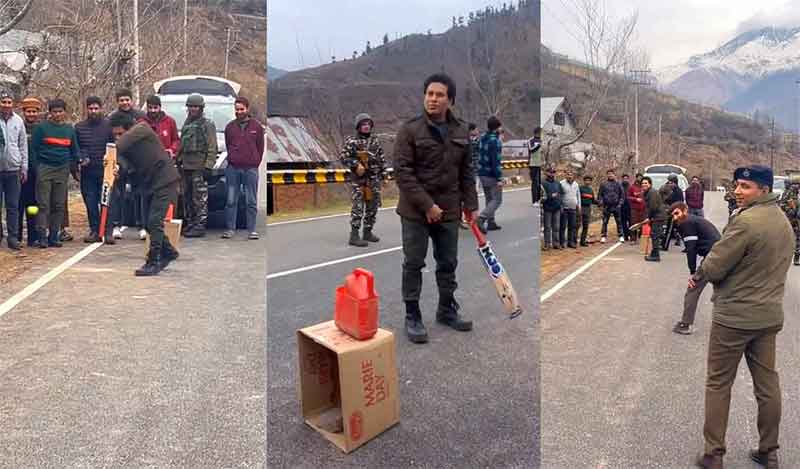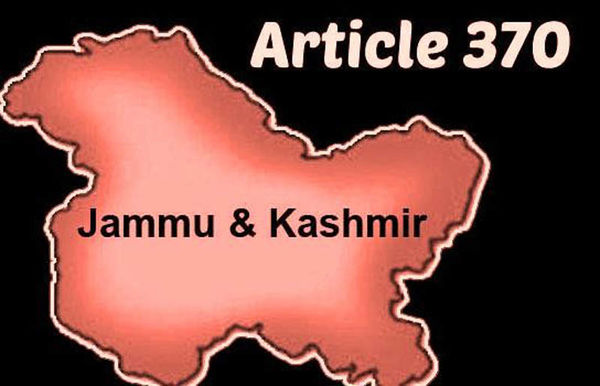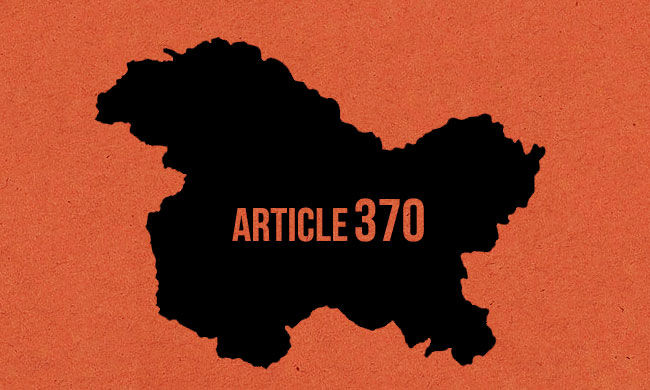
Prominent cartoonist Satish Acharya’s illustration in early October provided quite the insights into the recent gruesome developments in Kashmir. The piece features Shraddha Bindru, a Kashmiri Pundit, who’s holding the body of her murdered father, addressing the unknown killer –coward. The cartoon does justice to the mainstream media’s portrayal of the ‘Muslim terrorist’. The bearded man with a gun in the cartoon completes the picture. Those who may be unfamiliar with the backdrop of the cartoon may not understand this piece. On October 6, unidentified assailants shot dead a 68-year-old Kashmiri Pundit, Makhan Lal Bindru near Iqbal Park. In late 1989, when thousands of Kashmiri Brahmins started leaving the valley, Makhan Lal Bindru afforded his confidence in the local Kashmiri Muslims and stayed back in the valley. There are still eighty-six such families that have been living in Srinagar. Whenever the Kashmir dispute finds its mention in our discussions -whether it’s the atrocities that have claimed lives of Kashmiris, sexual violence against Kashmiri women, the outrageous seizure, and eviction from their lands, the issue of demographic changes, the malicious attempts of dispossession of Kashmiris, exploitation, and diversion of their resources, and the objectification, exoticism as well as stereotyping of Kashmiri body especially women –the exodus of the Kashmiri Brahmins dominates the narrative. As if it’ll somehow balance out the atrocities and justify the oppression against the local Muslim population. The exodus acts as a tool of justification for India to mobilize support for its misgovernment in the valley.
The guilt of the ‘exodus’ is instilled in the majority population in the valley to render them culpable in events that stretched beyond their control. In a practical sense, the majority itself has been at the receiving end of the political games, and oppression. Bindru’s run a prominent pharmaceutical business in the heart of Srinagar. Makhan Lal Bindru’s son Dr. Sidhartha Bindru is a well-known diabetologist in the valley and his daughter is an Assistant professor outside Kashmir. The confidence that the Bindrus entrusted to the majority community in the 1990s remained without a stain despite the eerie dance of the deteriorating security situation in the valley. His assassination shocked the valley attracting wide condemnation across all sections of the society and political thoughts. However, the comments of M.L Bindru’s daughter at the funeral pyre weren’t received well. Her comparison with her upbringing and that of the killers drew quite a line. She said that her father educated her, whereas the murderers offered their children only bullets and stones. Though the remarks may seem to be referring to the killers, it doesn’t take much time to understand that the allusive comments were directed to a much larger target. Since the bullets and pellets have become synonymous with Kashmir, especially Kashmiri Muslims, it’s apparent that she made these remarks ascertaining that the killers were Muslims.
Unsurprisingly to our surprise, unknown killers throughout the history of their existence have always remained unknown in the valley, playing a crucial and bloody role to further political games. The declaration came when nothing about these ‘unknown killers’ is known, neither has there been anyone held accountable. Besides that, she also advised Kashmiris to pursue education, boasting about herself, her brother’s medical credentials, and her mother’s pharmaceutical business. Though the local population quite understood her remarks were under the influence of her grief, she sure did walk on their nerves.
Out of the twelve scholarships in the Inheritance of the Citizenship of the Kashmir 1927, only one was granted to the local Muslims. Apprehensive of the protests from the Muslims from both Jammu and Kashmir, Maharaja announced scholarships for Hindus as well as Muslims in addition to some of the posts reserved for Muslims only. To assuage the allegation of appeasement of Muslims, the Dogra government withdrew the order.
At this time, and by the establishment of the Glancy Commission, only 2% of Muslims were educated, and very few of them were employed in government jobs. Kashmiri Pundits though being the minority enjoyed the patronage by learning the various court languages and held key positions under various governments. On the other side, Kashmiri as a language never received any support, though that’s a fate that it’s held for many centuries. Prompted and dissatisfied, Pundits couldn’t even make peace with the share of Muslims in Jobs and legislature, and hence, spearheaded the ‘roti –bread movement. This is the saga of history –a consequence of occupational politics – in which the rulers were the minority Hindus, and the subjects were majority Muslims. The modern Kashmiri history substantiates this unequal power dynamics where one community enjoys the privileges, and the other is dispossessed.
Shraddha Bindru either because of grief over the death of her father, or any other reason known to her has spoken out, perhaps only to belittle and challenge the education of Kashmiri Muslims. She must be of the opinion that education is achievement confined and unique to ‘Pundits’ only disregarding the fact that the highly-educated Kashmiris have been at the forefront at the resolution of the political uncertainty of their homeland. In the last seventy years, the oppression, dispossession, and torture of the majority community of Kashmir have become a norm. Is Ms. Shraddha Bindru aware of the atrocities that the Muslim youth of the valley have been suffering for the last three decades? One can easily die in a case of ‘mistaken identity’ or be killed in any fake encounter. Pellets don’t discriminate against the ones on the road, or inside the house. Her Hindutva nationalistic tone was profound in her overhyped comments. Now that she is back in Delhi with a sense of relief; she won’t have to face the stone pelters or be surrounded by about a million patrolling troops. The least we can do is to hope that she’s safe. It doesn’t take much to comprehend that Shraddha Bindru’s argument is a leaf out of the Indian military narratives and the pampering Indian media. So far, no evidence underpins the role of ‘Resistance Front’ in the recent killings, and the group itself remains shrouded in mystery.
In October alone, several killings targeting both Kashmiris and non-Kashmiris shocked the valley. Among them were three Kashmiri Pundits, two Sikhs, two migrant workers, and 21 Kashmiri Muslims. Ten were killed in Srinagar, four in Pulwama, four in Anantnag, three in Kulgam, two in Baramulla, and one in Budgam –all insinuating the role of ‘unknown gunmen’. The unidentified killers remain in the darkness; among the dead, non-Muslims were even facilitated the funeral rituals, whereas Muslims were denied honourable burials away from their hometowns. Even for the sake of the argument, let’s assume that the murders were committed by the so-called unknown gunmen, but the killing of two Kashmiris by the Indian military after the assassination of M.L Bindru brings to the fore the absence of accountability and the impunity enjoyed by the armed forces that for the record are well-known.
Among the killed was a 26-Year-Old Pervez Ahmad from South Kashmir. After a day’s work as a paddy harvester, Ahmad was on his way home when he was shot dead by the Indian forces at the Check post near the Mongol Bridge, Anantnag. He’s survived by two young children, and seven family members, including his pregnant wife. Shockingly, the police forced the family to bury him hurriedly at midnight. In another incident, 21-Year-Old Shahid Aziz was shot dead by CRPF troops near Zainpora Village in Babapora of Shopian district. According to the CRPF, the civilian was caught between the crossfire between militants and forces, and accidentally Aziz was hit by a bullet. Eyewitnesses say that no such shooting took place, and he was deliberately shot with a bullet. His younger brother was one of the witnesses. Kashmiris are now being killed by the “unknown” and “known people”. Deterioration of the security of Kashmiri life since Aug 5 lays bare the tall claims of normalcy being projected in the mainstream media.
In another case, Shakir Ahmad Wani, a tractor drive by profession, is suddenly being held responsible for a non-Kashmiri killing, soon after he’s killed in an encounter. According to the brother of Ahmad, he had gone to the Pulwama court for a case-related work. Shakir’s brother asked a genuine question to the police. “Why wasn’t any of the intelligence wings enquiring their home, as is the norm?”. As what appears to be the Modus Operandi, Shakir’s body was also rushed for burial in the Kupwara town, away from his hometown. Adding to the pile of human bodies, Imtiaz Ahmad Dar a resident of Bandipora met the same fate. On October 5, Imtiaz was killed by the paramilitary forces. He was labelled as Lashkar-e-Toiba militant soon after he was killed while working on a paddy field. Jammu and Kashmir police chief Vijay Kumar referred to the killed men as Lashkar-e-Toiba militants, and some are regarded as ‘On Ground Workers’ (OGW)”. According to the official terminology, OGW’s provide logistics to the militants on the ground.
It’s no doubt that the people who have been living under the shadow of more than nine lac armed forces are likely to be dissatisfied. However, to intensify the alienation, the government of India deployed more troops, disregarding the need to engage in a political dialogue with the Kashmiris. The muscle approach is to punish them all, and there’s no way to punish them all, except to burn Kashmir. The militaristic democracy doesn’t understand words, home, hearts, and dialogue. Clamping down on the shady “unknown gunmen”, and in a show of power, the administration in Kashmir, arrested more than 1,000 people in the Kashmir valley, mostly affiliated with the now-banned JEI cadre. Many of them were sent to the Indian jails. During the visit of Amit Shah, motorcycles, as well as the doors of the rickshaws, were seized. Even the kids are being frisked now.
Salim Shah and Suhail Dar, two independent journalists from Kashmir were recently arrested. Mukhtar Zahoor, a photojournalist working in AlJazeera, has also been arrested. He reports for Caravan, Bloomberg, and Wall Street Journal as well. Many Kashmiri journalists have now completely stopped reporting. Only a handful of newspapers have managed to do justice with the news from Kashmir, and as far as the social media is concerned, Kashmiri’s writing on it, have been silenced, muzzled, arrested and outright banned. Others like American activist Mary Scully who is a vociferous supporter of human rights in Kashmir has had her account geo-blocked in India. In such an environment of repression where every genuine voice has been censored, media has either toed the line or been suppressed. Press freedom in the valley has fallen, to say the least. The culture of impunity that’s being practiced in the valley by the armed forces gives you an impression of the deteriorating state of affairs.
Despite all that occurred, and the bloody murders that happened in the month, Kashmiri Pundits and Sikhs have announced that they’ll remain in the valley, and there’s no question of them leaving. This confidence was bolstered when the local mosques from downtown Srinagar condemned the recent spate of attacks and assured the non-locals as well the non-Muslim community support of the majority. Those who are in Kashmir are to be trusted than those who judge from the outside. Perhaps, one day the unknown killers will be known, and the whole drama will be unveiled.
Kashmiri Brahmin girl Shraddha Bindru was praised for her comments; in the illustration, it created an impression on the Indian crowds. The poor family of Pervez Ahmed who died in the military firing may not be able to speak English, or they may not even agree to speak as opinions can be dangerous in the valley. They don’t have the financial resources to roam the courts, or to make the media line up in front of them; but can any of our Indian artists draw cartoons of the Kashmiri Muslims, who have been the victims of enforced disappearances, fake encounters, torture, and collateral damages at the hands of a ‘known army”, including that of the family of Pervez Ahmed?
Instead of fuelling the Indian public with virulent views against Kashmiris, mobilizing adverse public opinion on the people of valley, supporting the arbitrary arrests of the Kashmiri youth, and justifying the absence of accountability, will the Indian liberal’s side with the millions of Kashmiris who have been subjected to state violence, military mobilization, and political betrayals for decades?
Rama Sundari is with Progressive Organization for Women. And an editorial board member of magazine Matruka. She has translated Gowher Geelani’s book Kashmir: Rage and Reason into Telugu. By profession she is Head of the Electronics and Communications Department in a Government Polytechnic, Andhra Pradesh.















































